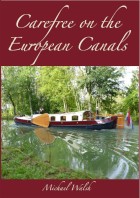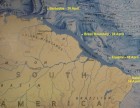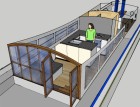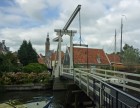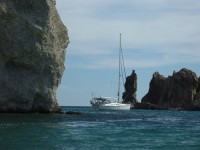Sequitur
Michael & Edi have headed out on a slow, thorough exploration of the globe.
| Vessel Name: | Sequitur and Zonder Zorg |
| Vessel Make/Model: | 2007 Hunter 49 and 1908 Wildschut Skûtsje |
| Hailing Port: | Vancouver, Canada |
| Crew: | Michael Walsh & Edi Gelin |
| About: | For our current location click, on Map & Tracking, then on the Google Earth logo. |
| Extra: | Follow us on Twitter: Follow @YachtSequitur |
| Social: |
13 January 2014
Another New Book Released
I am delighted to announce that my new book: Carefree on the European Canals is now in print and is available on Amazon.com, Amazon.ca [...]
26 April 2013
New Book Released
The proof copy of my new book arrived by courier today. I have approved it and it is now listed on Amazon for pre-order, with a publication date of 30 April. It is a rather large book at 680 pages in an 8.5 by 11 inch format with 315,000 words illustrated by over 2400 colour photos, charts and maps. [...]
24 April 2013
One Year Out of Brazil
One year ago today we sailed Sequitur out of Brazil after enduring more than six weeks in the least-friendly country that we had experienced during our three-year voyage. In the early evening of 24 April 2012 we crossed the line on the chart dividing Brazil from French Guyana and breathed a huge sigh [...]
27 October 2012 | Harlingen, Friesland
Planing a Metamorphosis
We have added a new post to the Zonder Zorg blog at: Planing a Metamorphosis.
29 September 2012 | Sneek, Netherlands
Onward to Friesland
We have arrived in Friesland and have added a new post to the skûtsje's blog at: Onward to Friesland
19 September 2012 | Hoorn, Netherlands
North From Aalsmeer
We have moved northward from Aalsmeer and I have added two new posts: Heading North From Aalsmeer and North From Amsterdam
13 September 2012 | Aalsmeer, Netherlands
Taking Possession
We are back in the Netherlands, and I have added some new posts to the ZonderZorg blog at: Taking Possession and Settling-In and Making Plans
20 August 2012 | Sequitur: St Augustine, USA - Michael & Edi: Vancouver, Canada - Nieuwe Zorg: Aalsmeer, Netherlands
Added a New Website
We have added a new website: Skûtsje ZonderZorg. Zonder zorg in Dutch means without worry. Our intention with the site is to provide a place to share some of the history, geography and culture of the skûtsje as we discover it. We will also use this place to document [...]
11 August 2012 | Sequitur: St Augustine, USA - Michael & Edi: Vancouver, Canada - Nieuwe Zorg: Aalsmeer, Netherlands
Still More Skûtsje History
We continued to attempt to track-down Douwe Albert Visser, who was the owner of Nieuwe Zorg in 1941 when she was re-registered. One of the problems we repeatedly encountered in our online searches was the effect of currently having Albert Visser and two Douwe Vissers as very competitive skûtsje racers, [...]
10 August 2012 | Sequitur: St Augustine, USA - Michael & Edi: Vancouver, Canada - Nieuwe Zorg: Aalsmeer, Netherlands
Some More Skûtsje History
While I was researching the history of Nieuwe Zorg, I finally found her first registration details obscured by an apparent typographical error in a transcribed online spreadsheet. She was listed as having been built in 1901 instead of 1908. I emailed the webmaster of the [...]
R&R in Valdivia


I hauled-out our shore-power cables and various adaptors and began to rig a connection to the electricity on the pier. I pieced-together a line with a Chilean plug on one end and a 125/250v-50 amp socket on the other and connected Sequitur to the shore-power. The breaker popped. This made no sense to me; the socket leads to an isolation transformer designed to take from 100 to 250 volts. The multi-metre showed 220 volts arriving at the socket, and my understanding is that the isolation transformer doesn't care about polarity.

I dug out the manual and opened the panel on the transformer and tried to make sense of things. The wiring and the wiring diagram agreed with each other, and in theory, things should have worked.
I cobbled-together another set of adaptors and tried the shore power to Sequitur's 125/250v-30 amp inlet. The breaker popped. My understanding of a transformer is that power comes into a coil, excites it and creates a load by transferring the power magnetically across a gap to an adjacent coil. If there is not an adjacent coil to take the power, then it is a short circuit and the current pops the breaker. What I was seeing appeared as if there was no adjacent coil to which the current could transfer.
As I delved deeper into Sequitur's wiring diagrams, the manuals for the two isolation transformers and Nigel Calder's 'Boatowner's Electrical and Mechanical Manual', the gauges on the paned indicated that the sun had quit work for the day. The battery was at 51%, and amps were beginning to flow out again.
On Sunday morning, with the battery at 47%, we took the 20 bus into Valdivia and transferred to the 9 bus, which took us to Sodimac. Inside we found a 550 Watt Black & Decker Smart Battery Charger, with an automatic three-stage charging system. We also picked-up a 25-metre extension cord, some plug adaptors, a coil of wire and an assortment of electrical connectors.
We took a taxi to Supermercado Lider and picked-up some fresh produce. Then with our heavy loads we walked a kilometre or so to the river and along it a couple of kilometres past the Club de Yates in-town marina to the bridge, where we caught the 20 bus back out the 8 kilometres or so to Sequitur. We had dramatically misjudged the distance from Lider to the bridge, but at least we got our exercise.

Back onboard I plugged the extension cord into the box on the pier and connected the charger to the house bank. I then plugged-in the charger, selected 'wet cell', poked the buttons to 30 amps and watched as our gauges seemed to give a nod of approval. I began by putting on a surface charge, bringing the voltage up to 14 volts, and then I continued with a deep charge. With no assistance from the sun or wind in the low overcast and rain during the next two days, the house bank gradually took a charge.

On Monday morning I walked over to Alwoplast, where they build large power and sail catamarans. I was impressed by the crisp, professional look of the offices, with Lloyds and ABYC certificates on the walls, and equally impressed by Ronald. I explained our situation and Sequitur's engine, alternator, generator and wiring problems to Ronald, and I asked if he could help. He said he was very busy with current work and wouldn't be able to do anything until the next day, and then only a bit. This was fine with me; I had at least stopped the bleeding and had set-up an intravenous. The patient was now stable.

We went to bed on Monday with the house bank at 59%. There was a nice positive amp flow and the voltage was reading 13.86, so I turned on the Espar to make some hot water, to add some heat to Sequitur's interior and to dry her out from the dankness of the recent weather. Even its tiny amp demand had been deemed excessive with the depleted battery, but now we were able to begin regaining comfort.

Mid-afternoon on Tuesday Ronald and Hector, one of his marine electricians came over to Sequitur, and I introduced them to the problems. For an hour they rooted-around in the transom locker, under the berth in the port-after cabin and in other spaces trying to resolve the isolation transformer and/or shore-power connection problem. Then Ronald needed to get back to running the business, so he left Hector to continue. He found a large resistance in the reverse Y adapter that I was using to connect the shore power to the 50 amp inlet. Though I couldn't see how this was popping the circuit, I asked him to butcher the Y and make-up a simple inline 30 amp to 50 amp adapter. He needed some parts, so he left for the day, with a promise to be back manana.
As I was rooting around the 50 amp isolation transformer in the space under the berth, where it had been installed by Specialty Yachts, I discovered well-hidden below it a small double circuit breaker panel. It had tripped. Immediately the light went on in my head; these breakers served both the 30 amp isolation transformer in the transom locker and the new 50 amp one beneath the berth. With these breakers off, there was no load for the transformer coils and a short circuit resulted. I switched on the breakers.
On Wednesday afternoon, when Hector had come back and completed the adaptor, I plugged-in the cord and we finally had proper shore power. I let Sequitur's system take-over from the Black & Decker, and we went to bed that night with the house bank at 82.5% and charging at a good rate.

Sequitur was secured bow-in in her slip, balanced between four lines. On her starboard side was a fixed steel pier of posts and beams, which gave us no possibility of using fenders. Because of eddies in the 2-knot tidal and river currents, and the nearly 2 metre tidal range, we needed to keep Sequitur off the pier. On her port bow was a narrow steel finger, low in the water with sharp edges and with no practical way of protecting Sequitur's hull from being damaged by it, so we secured her a metre or so off the finger.

Our access ashore was by scrambling out over the anchors, timing the surge of the boat in the current, and hopping onto the top of the railing on the float, and then down onto the boards. This was impractical, so I rigged a line from Sequitur's quarter to a cleat on the finger and with a couple of shackles, and attached Non Sequitur to it. Coming and going then became a matter of climbing down into the dinghy and gliding it along the line for the 5 or 6 metre shuttle.

On Wednesday afternoon we were visited by two Armada ratings. They came onboard to inspect our papers and then told us that we must report to the Capitania in Valdivia on the next day. On Thursday we took the 20 bus into town and walked along the malecon to the offices of the Port Captain. We presented ourselves and all of our papers, but they had no idea why we were there, and neither did we. After nearly an hour of their trying to figure things out, they finally told us all our papers were in order and there was no need for us to have come in.
We walked along the river to the Club de Yates Valdivia, got the access code for the wifi and spent a couple of hours getting an internet fix and catching-up on our emails and blog. Other than the security and maintenance staff, we were the only people in the place.

On the way back we stopped to look around the covered market along the riverbank near the bridge. Although it was late in the afternoon, most of the stalls were still occupied and there was a good selection of both produce and seafood available. We noted it for later, and continued back to Sequitur.

We arrived back onboard to find the house bank at 100% and on float charge. To save diesel oil, I switched on the electrical water heater and plugged in a couple of electrical heaters, and turned down the thermostat on the Espar furnace. Sequitur's electrical system was now off the critical list, but still on life support.
With the electrical system stabilized, we decided to rent a car and drive to Argentina to renew our Chilean visas. We had returned to Chile from our Arequipa, Lake Titicaca and Bolivia trip on 5 January, so our three-months were up on 5 April. Edi had fond memories of her visit to San Carlos de Bariloche in 1980, so we decided to head there.

We reserved a car from the Europcar office in town and on Thursday morning, the 31st of March we drove off to the south and east to Paso Cardenal. Again, as on our previous two road trips in Chile, we found that the locals must all know their way around, and that there was no need for directional road signs.

We did eventually find our way to the summit of the pass, in the middle of the widest no-man's-land we had ever seen. It is 31 kilometres between the Chilean Customs post and the Argentine one.

We stopped at the first community we came to, which was over 100 kilometres beyond the last Chilean one. Puerto Villa la Angostura is a town very much like Whistler, back home in British Columbia. It seems to be both a summer and a winter sports hub, with lakes, rivers, mountains and ski resorts. After hours of almost no traffic, we were in a crawling traffic jam. It was mid-afternoon, and we hadn't eaten since breakfast, so we stopped to look for a restaurant.
We looked at several places, none of which had interesting menus, and we finally settled for a place touting its authentic Patagonian cuisine and in which there were several tables of diners, normally a good sign. Being in Argentina, we thought we couldn't go wrong with beef tenderloin steaks with mushrooms. We were terribly mistaken; it was a horrible Teutonic rendition. We added a new entry on our list of worst meals.

We were getting deeper and deeper into German influence. Los Rios region around Valdivia, Los Lagos region to its south and the area we were heading into in Argentina were one of the favourite destinations for German emigrants. After WWII, San Carlos de Bariloche became one of the main hiding places for Nazis fleeing prosecution for war crimes. The countryside looks very much like Bavaria, the names on the billboards and businesses are heavily Germanic, the architecture is a blend of Schwartzwald, Bavarian and kitsch, and but for the Argentine license plates on the cars, we could as easily have been in Bavaria. We saw several businesses named Arrayan, or Arayan.

San Carlos de Baraloche sits on the southern edge of a large lake, which is part of a chain about 100 kilometres in length. It is in the eastern foothills of the Andes, and peaks rise up to a little over 2000 metres behind the city.

We found a very comfortable room in a new twelve-room hotel on the hill with a view over the historic centre of the city and the lake just below. We were still hungry after our very disappointing lunch, so we asked the desk clerk for a recommendation for dinner. He told us that a short walk away is a wonderful German restaurant.

We arrived at the door of Tarquino Parrilla-Restaurante, which is housed in an amalgam of massive posts and beams that are variously curved, carved, hewn and fitted into place. The place seems to be waiting for the arrival of Hansel & Gretel or maybe it is a leftover from a movie set for the Hobbit.
Edi had a goulash mit spatzle and I had a huge platter of veal sweatbreads with accompanying sauces, and we enjoyed our delicious dinners with bottles of Warsteiner. Because Sequitur's cuisine is so wonderful, we seldom feel the urge to dine out; it seems that we do so only when forced to by a trip away. The restaurants we chose; therefore, have a tough standard to meet. This one just made the mark. With our bill came a discount coupon for chocolate in one of the city's many chocolate works; the area is apparently famous for its chocolate. We asked the waitress for her recommendation, and she told us the one on the discount coupon wasn't her choice. She suggested Torres.

We were nearly out of chocolate aboard Sequitur, and we had been amazed at the utter lack of unadulterated chocolate we had thus far seen in South America. All that we had found listed sugar as its first ingredient, was heavily milked, and/or was full of various fruits, nuts or other distractions. Finding a 70% or 80% chocolate increasingly became our goal as our supply onboard dwindled. We had seen many specialty chocolate shops in Valdivia; in fact, the chocolate business is listed as one of that area's prime industries. Our visits to several of them found us nothing but chocolate-flavoured sugar and milk confections.

Back in our hotel room, we searched online for chocolate in the Baraloche area, we asked the desk clerk, and we went to bed dreaming of finally replenishing our chocolate cache. After the insipid coffee and the nearly inedible commercial bread and pastries of the continental breakfast in the hotel on Saturday morning, we checked-out and headed off to the Torres works. We explained to the sales clerk what we were looking for, and she seemed apologetic as she offered us a taste of their least adulterated. It was sweet, waxy and mundane. It seems there is no demand for what they all call bitter, but what we think of as chocolate.

We headed back into the centre of town and down a hill that reminded us of San Francisco's Lombard Street. Bariloche's Dr John O'Connor is a similar steep, one-way, switchback two-block descent.

As we headed back toward the Chilean border, the sky cleared and we enjoyed marvellous views as we drove around the eastern and then across the northern shore of the large lake. The mountains of this region reminded me very much of those on Vancouver Island. They are about the same height, 2000 to 2200 metres, and have similar structure and vegetation.

The spires on one of the mountains look so similar to those in the McKenzie Range, where I had made many pioneering ascents in the 1960s and 70s, that I thought I was back on the Island.

Clouds rolled in as we approached the summit of the pass, but not enough to fully obscure a steep peak that looks very much like some of my old haunts on Vancouver Island.
We checked-through the Chilean entry post and our passports were stamped for another three months. We are now good until 1 July. When we had finally wound our way out of the mountains and back to the highway, we turned south. We had decided to visit Puerto Montt, the southern terminus of Pan-American Highway. Among other things, we wanted to survey the marine facilities and the grocery shopping for Sequitur's planned arrival.
Edi had seen signs for a Holiday Inn, and we spotted it very quickly as soon as we had arrived in the downtown. It occupies the top six floors of a new eleven-storey building on the waterfront, in the heart of the historic district. We drove into the secure parkade and took the elevator to the eleventh-floor lobby and checked in.

Once we had settled into our very big, ultra-modern tenth-floor room with its marvellous view out over Seno Reloncavi, we began to think of dining options. We hadn't eaten since our mid-morning bland and simple breakfast in the hotel in Bariloche, and it was already early evening. Knowing that we were one in three on dining on this trip, and not wanting another disappointment, we took the elevator down to the huge Supermercado Bigger, which is a part of the new complex. There we bought a barbequed chicken, a baguette and a bottle of wine and took the elevator back up to our room, where we enjoyed a wonderfully relaxing dinner overlooking the sea.
After a very nice breakfast in the hotel, we took the elevator down to the supermarket and filled a cart with all the heavy, bulky and awkward groceries we could think of needing in Sequitur. These would have been a chore to fetch by bus, but with the car, they presented no problem. We wheeled the cart down the moving ramp to the car in the parkade, and then took the elevator back up to our room to pack-up and check-out.

Thus far we had a limited our touring of Puerto Montt to rides up and down the elevators. It was time to explore the marinas. We drove out of the parkade and onto the waterfront road, Avenida Diego Portales, and followed it the six kilometres or so to Marina del Sur. We arrived to find that the office is closed on weekends. Of the three main marinas here, this one is reputed to be the most exclusive and expensive.

We continued along half a kilometre to Marina Oxxean, where we spoke with the lady in the admin office. She told us that she would have a price list put together for Sequitur and emailed to us on Monday, when the manager returned. While we were out on the floats checking-out the facilities, we spotted Odyle, with Steve hanging from the mast. Actually, he was suspended in a bosun's chair varnishing the mizzen.

We had last seen Steve, Kim and Cullem in La Punta, Peru in November, when they had sailed south. They had just returned from exploring down as far as Laguna San Rafael, 320 nautical miles to the south. We stood on the floats chatting for half an hour, harvesting a lot of local knowledge of the area from them. Among other things, we learned that the travel lift at Oxxean was not working, but that there was a good one just down canal at Reloncavi, where they also have very good dry-storage facilities.

We bade Steve and Kim farewell and drove down to Club Nautico Reloncavi. The lady in the admin office poked Sequitur's dimensions into her computer and from the screen, prepared a list of charges for their various services. The fees seem very reasonable: 96,750 (less than $195) for a two-way haul-out, 21,500 per month dry storage, 43,000 per month for mooring on a float and 200 per kW/hr for electricity. We went out to inspect the travel lift.

Its plaque showed it to be well able to handle Sequitur's weight and dimensions. We walked the floats, and they look rather modern and well-maintained. We were very pleased with the marina, and will most likely use it in June to haul-out and work on Sequitur and to take a break before continuing south.
We drove back up the Pan-American Highway the 160 kilometres to Paillaco, and then cross-country another 50 through Valdivia to the marina. Sequitur's batteries were still at 100%, the water tanks were full and once we had ferried our groceries aboard, so were the pantry, fridges and freezers. It was good to be home again.

